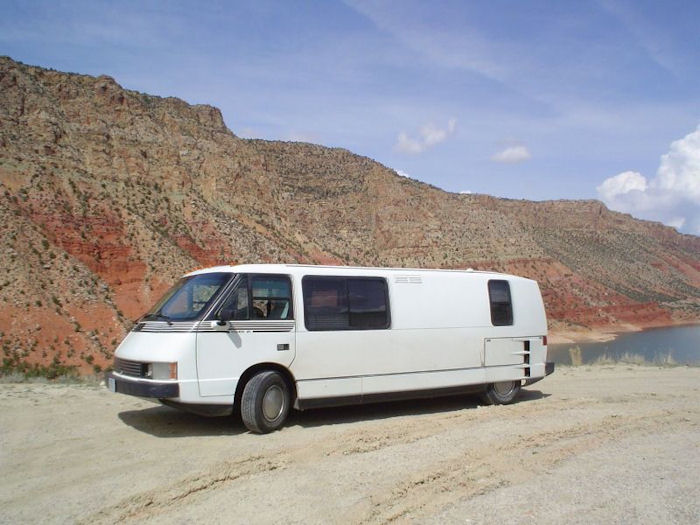
The Vixen RV Was Considered the Sports Car of Motorhomes
Just looking at the Vixen RV, and you can tell it’s unlike any other motorhome ever made. It’s a strange hybrid between a Class A and Class B RV, with the luxuries of a motorhome and the height of a camper van. But that’s not where to oddities of this 80s RV end. So let’s dive headlong into the sports-oriented RV you’ve probably never heard of.

The wacky origins of an RV built for car enthusiasts
In the 80s, most big RVs were total gas guzzlers, thinking very little about fuel efficiency, handling, and aerodynamics. At the time, the most innovative motorhome was built by GMC, and lasted from 1973 to 1978. It had new interior features and pioneered the smooth exterior found on many Airstream campers and RVs today. But Bill Collins, a designer for the legendary DMC DeLorean, wanted in on the action.
So he created Vixen, and designed fully enclosed RVs with bedrooms, kitchens, and bathrooms, that weren’t just big. His RV was efficient and clever, as to make it useful for everyone. For starters, the length and height of the first Vixen TD motorhomes, at 21 feet long and 7 feet tall, meant it could fit in a garage. And it featured an automatic roof that could increase the headroom to 6′ 6″ at the push of a button.
On top of that, Vixen RVs were designed in a wind tunnel. Something very few (if any) RV manufacturers could boast at the time. And it gave the Vixen an alleged .3 coefficient of drag. For perspective, the Tesla Model 3 has a coefficient of drag of .23, which isn’t that far off from this motorhome.
This streamlined shape was molded using lightweight fiberglass materials, meaning the Vixen RV weighed in at just 5,100 lbs. As a frame of reference, a base model Ford F-250, at 19 feet long, weighs over 5,600 lbs. All of this combined made it one of the most fuel-efficient RVs available.
The engines and transmission of the Vixen motorhome

Over the course of its three-year run, from 1986 to 1989, the Vixen RV had three engine options. It started with 2.4-liter turbo diesel that made 115 horsepower, which is tiny in comparison to other RVs of the era, but plenty considering that the Vixen was a tiny RV. But toward the end, it wound up with a 3.6 liter fuel-injected V6 that made 165 horsepower.
But what really made it a “sports car” in a sense was that the early versions of this RV were fitted with a five-speed manual. Manual RVs were pretty much nonexistent, even in the early days of RVing. However, that manual transmission, and all the engineering that the Vixen went through, returned unheard of RV fuel efficiency. Depending on the engine, the economy ranged from 22 to 30 miles per gallon. Pair that with a 23-gallon tank, and you’re good for over 500 without having to pay hundreds of dollars for gas every time you fill-up.
And while weight was saved on the body, the Vixen was still packed with amenities.
Features inside the Vixen RV

Inside a Vixen, you’d find a full-sized double bed in the back, and a walk-in bathroom with a shower, sink, and toilet. There was also a kitchen, which had a microwave and a refrigerator. And there were 25-gallon freshwater tanks, 18-gallon grey water tanks, and 12-gallon black water tanks underneath.
What you had was an RV that could fit anywhere and be driven by anyone. Unlike traditional RVs, which towered over everyone like busses and semi-trucks, the Vixen could actually handle the road. After all, the center of gravity was designed to be lower.
And above all else, these RVs were total gas hogs, allowing for relatively inexpensive RV trips. In fact, at today’s average gas prices, you could fill it up for about $80. My Acura, which requires premium fuel, costs about $60 to fill. So $20 more dollars isn’t too much more to ask.
But the Vixen wouldn’t last, despite all the good things about it. But just because the company is gone, does not mean it’s forgotten.
The unfortunate demise of this wonderful idea

I’ll start by saying that the reasoning behind Vixen’s demise made sense. These purpose-built RVs ended up costing $40,000 to $53,000 when new, which hovers around $100,000 in today’s money. And even though the ideas are sound, very few people wanted to fork over that much money on a motorhome.
What’s more, only 587 Vixen RVs were ever built, making them exceedingly rare. However, that doesn’t mean they’re not still around. The website Vixen Motorcoaches still has records and information on these old, forgotten RVs. And if you dig hard enough, you may even find a few for sale.
So now you know about this strange, offbeat RV that defied the major manufacturers. It produced an unique, fuel-efficient RV that could truly be used by anyone.


